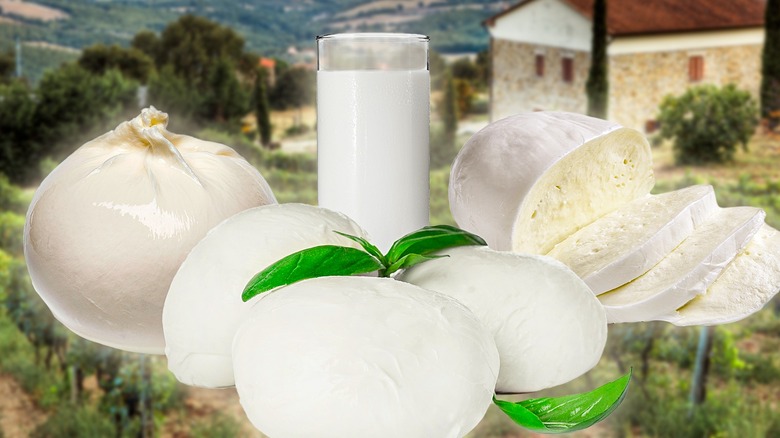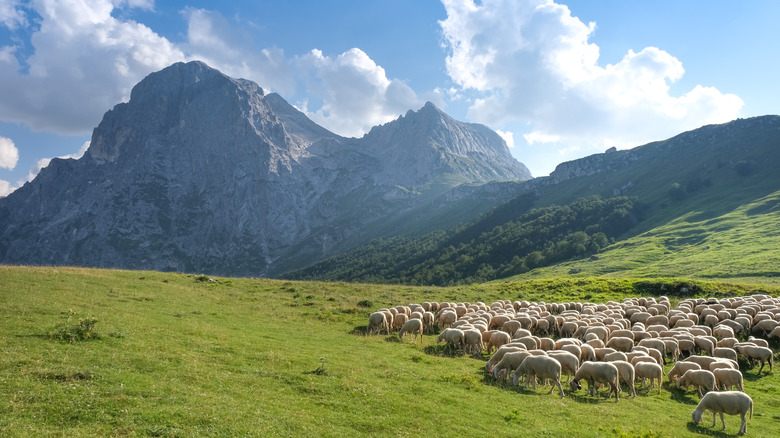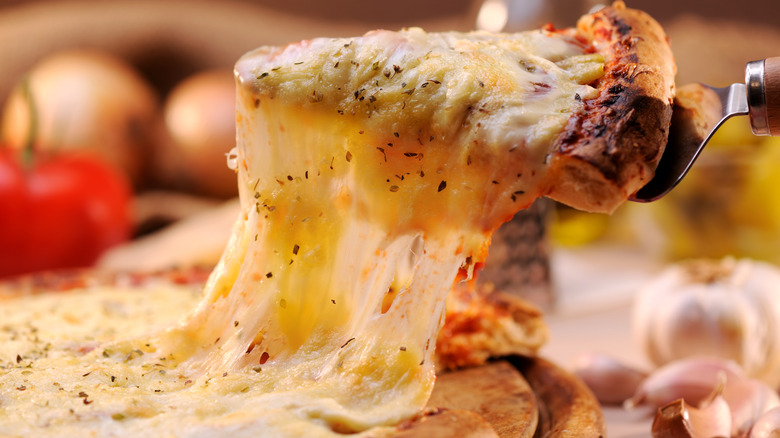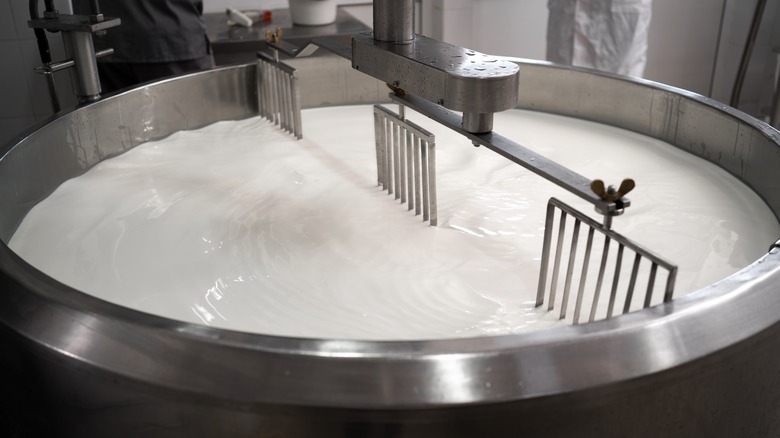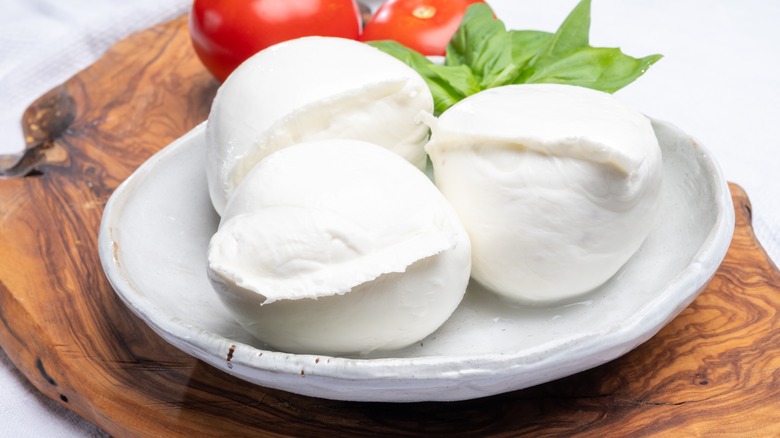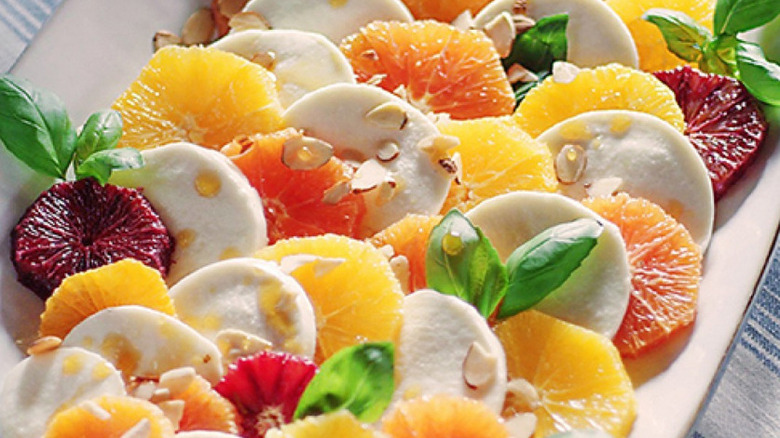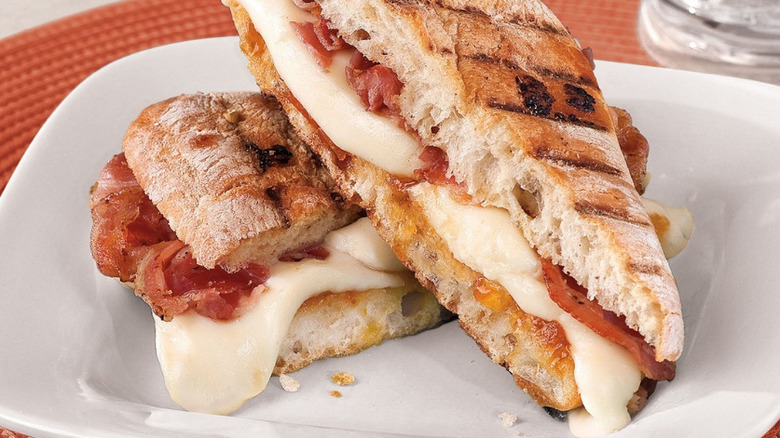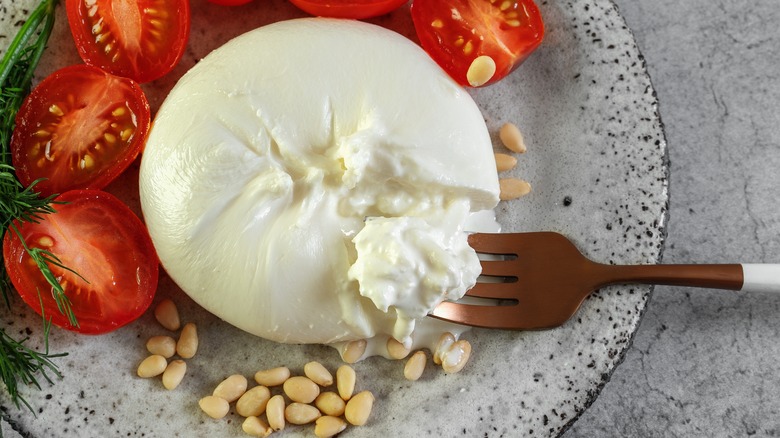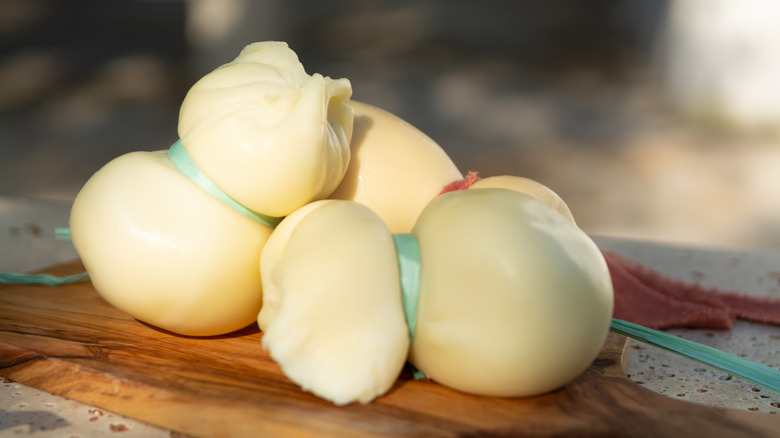What Makes Fresh Mozzarella Different Than Other Varieties And The Best Ways To Enjoy It
Mozzarella isn't just a fun word to say (with an Italian accent, gesturing with your hands), it also brings up images of stringy, stretchy, melted cheese, usually alongside pizza or lasagna. Though this delightfully gooey cheese is enjoyed in a number of melted cheese recipes, fresh mozzarella is one of few cheese varieties best enjoyed as is and either as soon as it's made or within a matter of days. Part of what makes fresh mozzarella different from other varieties is its higher moisture content, which gives the cheese a softer, creamier texture. It also means it has a shorter shelf life.
We had the opportunity to speak with chef Marco of Galbani cheese to discuss what makes fresh mozzarella so special and some of the best ways to enjoy it. From eating it sliced with tomatoes to topping hot soup or tacos, fresh mozzarella takes an array of dishes to a luxurious level. "Mozzarella's versatility sets it apart," chef Marco tells us. "It has a texture and flavor profile that make it perfect for many different styles, recipes, and ethnic dishes."
The origins of fresh mozzarella
From southern Italy, reportedly sometime in the first century, mozzarella was born. It's said that Roman monks supplied travelers with mozza cheese for their journeys. But it wasn't until the 12th to 16th centuries that mozzarella was created to ship to markets for sale. Mozzarella was then transported throughout the European continent and overseas once refrigeration was available. Regardless of when it came about, mozzarella was originally made from sheep's milk before it was made from buffalo milk. Mozzarella di bufala would make its cookbook debut in 1570. These days, however, cow's milk is commonly used to make mozzarella (aka fiori di latte).
Mozzarella was named after the hand-spun process in which it's made; mozzare translates to "cut off" or "remove from". Curds are separated and removed from whey during the process of making mozzarella. The cheese curds are then stretched and kneaded like dough, which gives it a shiny, smooth appearance, almost like marshmallow. And like dough, fresh mozzarella is formed into a ball, braid, or knot. It's part of a group of cheeses known as pasta filata — meaning "spun paste" — which also includes provolone (which is aged longer rather than cured in brine water, which is what sets it apart from mozzarella), as well as caciocavallo.
Why mozzarella is so popular
Mozzarella is super popular among Americans, which should be fairly obvious given the popularity of pizza joints in the U.S. But it's also the second most popular cheese around the globe. The demand for mozzarella plays a pivotal role in why today's mozzarella is made from cow's milk. An increase in supply meant switching from harder-to-source buffalo milk to easily accessible cow's milk. This switch in milk source affected more than the bottom line of supply and demand; milk from cows produces a milder tasting mozzarella cheese.
Though fresh mozzarella is a versatile cheese that can be enjoyed in hot or cold dishes, why it's so popular goes beyond just its use. Certainly, mozzarella provides a rich cheesy taste, but there's just something about mozzarella that separates it from the rest. We asked chef Marco what he thought was the reason for this. "I'm a chef. I live to create recipes that bring a smile to my guests' face and keep them wanting more," he says. "A good, quality mozzarella dish is a great way to make that happen."
Indeed, mozzarella has a way of bringing people together. That's true whether it's to share a giant pizza on a Friday night or "ooh and aah" over the serving of lasagna at the Sunday dinner table.
It's the milk that makes the difference in mozzarella
Fresh mozzarella isn't just a cheese; it also indicates a specific process for cheese making. Mozzarella can be made from any type of milk, whether it's the traditional use of cow or buffalo, or even the less popular sheep or goat milk. The difference will be in the resulting taste and texture, chef Marco tells us.
"Goat cheese is lower in fat and therefore will finish drier, resulting in a mozzarella that is not as creamy," he says. "On the other hand, sheep milk is higher in fat than buffalo milk, which results in a richer, creamier cheese." Meanwhile, what makes buffalo mozzarella different than modern mozzarella is buffalo milk gives a deeper, more intense flavor than cow's milk, and it contains almost twice as much fat. Cow's milk creates a mild cheese with less bite. This is perhaps why we don't often see more mozzarella made from animals other than cows.
What makes fresh mozzarella different from other varieties
Fresh mozzarella is different than other varieties because it's soft and airy, pliable, and rather delicate. The reason for this is because it features a higher moisture content — which starts with how it's made. This includes a quick cooling step by placing the cheese in a bowl of ice water once it's shaped, as chef Marco explains. Compare that process to packaged mozzarella — the kind you find in your grocer's refrigerator section — as an example. Its longer method of aging promotes the loss of moisture, which not only leads to a drier cheese but a saltier one as well. Packaged mozzarella may also have a denser bite.
"Fresh mozzarella is unique because it is a 'blank canvas' ingredient," chef Marco tells us. "That means chefs and home cooks alike can use it as a foundation for a variety of dishes. The fresh creamy taste and texture work with every type of dish — sweet, savory, hot, or cold."
It may have a lighter taste profile and not feature a creamy center like some other varieties, but fresh mozzarella's distinct nature is what makes it stand out, even when it blends in. Mozzarella remains one of the best cheeses to use for pizza.
Can fresh mozzarella be enjoyed cold?
Fresh mozzarella has a short shelf life — as mentioned, it's typically best to consume it within a few days. Chef Marco has let us in on the best way to keep it fresh. "To keep fresh mozzarella at its best, I use two different storage methods. First, tightly wrap the cheese in plastic wrap before refrigerating it," he says. "You can also submerge the mozzarella in a container of cold water and store it in the refrigerator."
But can it be enjoyed right out of the refrigerator? Though most folks may not think to grab a handful of packaged shredded mozzarella as a stand-alone snack, fresh mozzarella just begs to be eaten as is. And with so many ways to use fresh mozzarella, it would be a shame to not partake in fresh mozz right out of the fridge. If you can wait, though, let it come to room temperature for the best mozz taste.
Chef Marco features fresh mozzarella in cold, neutral, and hot dishes alike. He tells us, "I like to impress with a beautiful spinach and berry salad or with something unexpected like caprese pancetta tacos, which are filled with fresh mozzarella, cherry tomatoes, basil, crispy pancetta, and balsamic glaze." Sounds divine.
Ways to enjoy fresh mozzarella warm or melted
Your first thought when it comes to mozzarella is probably the way it melts when heated and whether or not it delivers creamy, ooey-gooey goodness that won't get stuck in your teeth or turn into a rubber band. Or is that just us? Fresh mozzarella melts differently than other varieties, including the packaged mozzarella in your local grocery store. But all in all, mozzarella is the king of melted cheese.
We checked in with chef Marco for some of his favorite ways to enjoy melted mozzarella. He warns us, "It is tough to pick just three!" But he has a classic recommendation that highlights the best of fresh mozzarella, saying, "Fresh mozzarella margherita pizza with tomato sauce, basil, and that perfect layer of melty mozzarella on top." There's a reason why classics are ... well, classic. With endless dishes to create, chef Marco adds, "Personally, my favorite ways of using mozzarella are on multiple different pasta, dishes, pizzas, and grilled cheeses. One recipe I love is a panini, which combines creamy fresh mozzarella, salty pancetta, and sweet apricot preserves."
Fresh mozzarella requires a shorter amount of time to melt than traditional, packaged mozzarella, since it's much softer to begin with. Which is why making pizza with fresh mozzarella calls for a high oven temp and short cook time. Fresh mozzarella is best, then, for quick-cooking recipes in order to avoid burning, but it's versatile enough to toss into just about any dish.
The surprise creaminess of burrata
Similar to fresh mozzarella, burrata is shaped into a ball. But unlike mozzarella, burrata has a surprise cream center that's worthy of being its own treat — one we would encourage you try with a fork or spoon. Burrata begins the same way mozzarella is made; cheese curds are separated from liquid whey and stretched to elasticity. That's when it's shaped into a ball or knot. So what's the difference between mozzarella and burrata?
"Burrata is fresh mozzarella but filled with fresh cream. It's a lot more juicy than regular fresh mozzarella and is usually a little larger in size," chef Marco tells us. How is this masterpiece achieved? Mozzarella is stretched into a ball. A pocket is then created, making something that looks more like a bowl. Soft cheese curds are stuffed into the open pocket, which is then filled with fresh cream. The mozzarella shell is then shaped around the pocket to close off the opening and tied or melted shut.
Due to burrata's fresh nature, it's best enjoyed within a day. Try dipping your favorite food in the center or spread the creamy curds on your next meaty sandwich.
Smoked mozzarella adds richness and depth
Any type of mozzarella can be smoked, which changes the overall experience of this cheese, adding depth and richness. Plus, the type of wood you use for smoking and grilling can lend another layer of flavor. Chef Marco agrees, telling us, "With the right temperature, smoked mozzarella makes a beautiful, finished product!"
Of course, you don't want to melt your mozzarella all over your grill or smoker, so there is an art to smoking cheese. Smoking cheese is best done at a lower temperature since most cheese melts around 140 F. Fresh mozzarella can melt sooner since it's already so soft and light. In fact, you want to smoke mozzarella with almost no heat, around 100 F; but more importantly, you want consistent smoke for the entire length of smoking.
Smoked mozzarella can take your pizza to an entirely different level of pizza heaven, creating a gourmet pie of the skies. But there's no need to stop at pizza — try smoked mozzarella in your next smoked mac and cheese or grilled cheese. Consider using wood such as hickory, pecan, cherry, or maple to add a complementary note to your smoked mozzarella cheese.
What makes mass-produced, packaged mozzarella different?
As chef Marco points out to us, "Mozzarella has become a hit thanks to how we've incorporated it into main-street kitchens. All of our favorite Italian dishes can be enhanced with its beautiful, melted goodness." He adds, "Mozzarella is not just for pizza anymore!" Indeed, mozzarella can be enjoyed in a plethora of cuisines and recipes that go far beyond just pizza.
Where fresh mozzarella is a star in its own right, processed mozzarella cheese you find at the store has its place as well. It's convenient to have on hand and can withstand longer cook times than fresh since its moisture content is much lower. The main difference between fresh mozzarella and processed mozzarella is the latter's dryness, as mentioned, as well as shelf life. Fresh just doesn't last that long and preservation is necessary to bring mass amounts of mozzarella to the public. But in order to consistently execute a recipe, ingredients need to be consistent as well.
"I think the difference between mass-produced/store-bought mozzarella is that mass-produced is created for continuity, and to be used in a restaurant setting to offer a consistent, precise product," chef Marco explains. "Homemade mozzarella can be inconsistent in size, taste, and texture each time it is made."
What to use in place of fresh mozzarella
If you're a cheese lover who makes lots of recipes that call for cheese, having mozzarella on hand is an obvious suggestion for your refrigerator. But what if you just don't have any mozzarella and your recipe needs something like mozzarella to complete it? You can always reach for provolone or caciocavallo, since they reside from the same cheesy pasta filata family. They may not melt the same, but they do provide a mild, creamy bite that's lightly tangy and a little salty. Both cheeses are aged and therefore much drier than fresh mozzarella; a shredded version of provolone or caciocavallo is similar, then, to mass-produced mozzarella.
Scamorza is another cheese similar to mozzarella but with its own unique profile. It's also an aged cheese that dries longer than mozzarella. Part of the spun-cheese crowd, as well, scamorza tastes like mozzarella but has an intensity to it thanks to a salty, smoky flavor. Though it has a heartier bite than mozzarella, scamorza cheese melts well and can be used in many of the same dishes that call for mozzarella.
